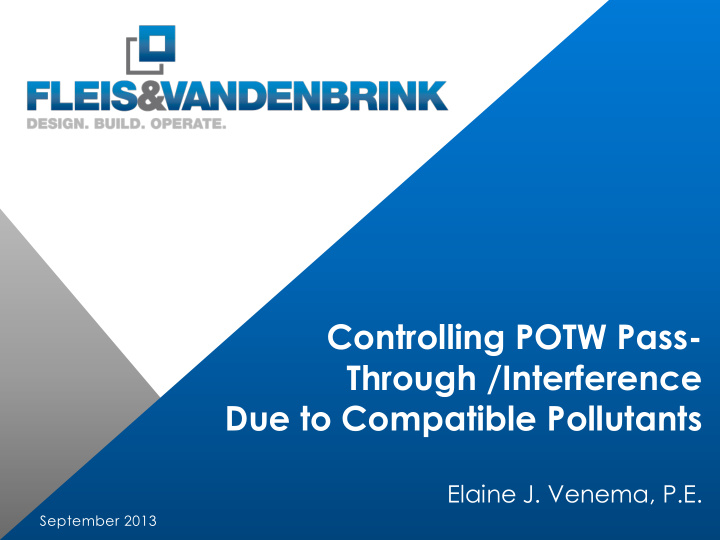



Controlling POTW Pass- Through /Interference Due to Compatible Pollutants Elaine J. Venema, P.E. September 2013
Nutritional Supplements/Dairy Fruit Processing/Canning Pickling Operations Tannery/Rendering Flour/Grain Mills Egg/Poultry Breweries
Win-win solution Protect the POTW (collection & WWTP) and the environment Maintain or attract industry Good for the community!
Community Expectations/Goals Industry Needs/Expectations Finances/Funding Opportunities
Source Treatment Full Treatment: Separate from POTW Direct discharge Challenges Pretreatment: Screening Primary Treatment Solids Separation Chemical Addition Biological Pretreatment
Variable waste loading Need operations staff Treatment onsite not always desired/feasible Discharge (NPDES or GW)
Determine what level is needed for win-win Waste minimization & Best Management Practices Pretreat to “domestic” And everything in between!
Waste Stream Segregation Equalization/Slug Prevention Sidehill Screen Sidehill screen, or other Grease interceptor (larger than this one) Grease Interceptor
Concentrate waste products Belt Press To be hauled to POTW/anaerobic digester Solids separation (belt press, etc) Can waste solids be used as livestock feed?
Tannery Food Supplement Mfg
High BOD, and Toxics Hair/Flesh FOG Leather chunks Slug loading Making … “Soft Corinthian Leather” Project Planning: Hides per day Capacity Evaluation Meetings with SIU Pilot Studies Estimate Odor Control Needs SIU Decision – Independence from POTW http://leather
Full Treatment Onsite Oxidation Ditch NPDES Discharge
Evaluate short rock media TF tall plastic media TF Project Planning: Capacity Evaluation Meetings with SIU Capacity modeling GPSx Pilot Study Estimate Odor/Corrosion$ Industry Reconsideration
Pilot Study Towards … 13,000 #/Day
Pilot study and evaluation: a TALL trickling filter is req’d Financing: cash + grant Discussions with industry Initial decision: pH pretreatment/equalization: Not just WWTP improvements: Long F.M. with high BOD/Temp Final result: SIU built pretreatment onsite, SBR Discharge to POTW : Domestic strength BOD, TSS
So you want to treat at the POTW, now what? Next Steps: Capacity Analysis Ordinance/Legal Review & Determine Local Limits WWTP Improvements, if necessary
Capacity Analysis: Evaluate flows & loads Engineering calculations – MAHLs, AORs, organic loading, hydraulics Identify processes with insufficient capacity – Headworks ? Secondary Trt?
Install more blowers Switch out media (e.g. rock trickling filter plastic media) Add media to aeration tanks (e.g. Conventional AS IFAS) Construct influent equalization
Construct parallel treatment units Expand existing tanks – deeper SWD Add roughing and/or polishing treatment
Negotiate with industry to pay for upgrade All? Definitely pay their fair share (“proportionate”) Have industry pay for a portion of upgrade Especially effective if a WWTF upgrade is planned already and a few additional improvements are needed to accommodate the industry MEDC or Economic Development Authority In conjunction with USDA RD grant/loan; SRF
Capacity Analysis: Blueberry Processor Pickle Processors
Groundwater discharge … no longer an option WWTP Improvements were needed (switch from groundwater to surface water discharge) Identified Industry needs discussed future BOD Trt needs vs production GREAT Marriage (win-win) of Tanks with available treatment volume … minimum HRT A home for Lots of MBBR plastic media … enough for berries “Tell ya what … buy s’more plastic and couple of blowers, we’ll call it good, Vinnie” Then, we’ll dedicate the service capacity.
Lagoon MBBR
Lagoon MBBR
COD in lieu of BOD5 This is so Important Shows up in the anaerobic digester, not Aeration Tank Acetic/lactic acid is biodegradable Seasonality of loading is large Like clockwork- peaking in August Biogas production is (mostly) wonderful Historic odor & corrosion in 27 mile FM big problem Slug loading noted at the digester AND big biogas
100000 Pickle ckle Production uction takes es 90000 off in Mid id-Augus ugust 80000 70000 60000 ay) as (cf/day 50000 Biogas 40000 30000 20000 Actual Biogas Low Estimate of Theoretical 10000 High Estimate of Theoretical 0 08/03/12 08/23/12 09/12/12 10/02/12 10/22/12 11/11/12 12/01/12 12/21/12 01/10/13 Date
COD in lieu of BOD5 Sticks well on biofilm/media (if no digester) Project in the planning/preliminary design phase Review of industrial flow/BOD
Surcharges were applied based on BOD5 How well did that reflect the loading? (COD not BOD5) Two-stage attached growth is great NPDES protection No biomass “washout” + biofilm “pockets” Expansion is desired – Over Doubling! (see previous steps) Recommendation: Treat at the POTW, increase capacity
Recommend
More recommend